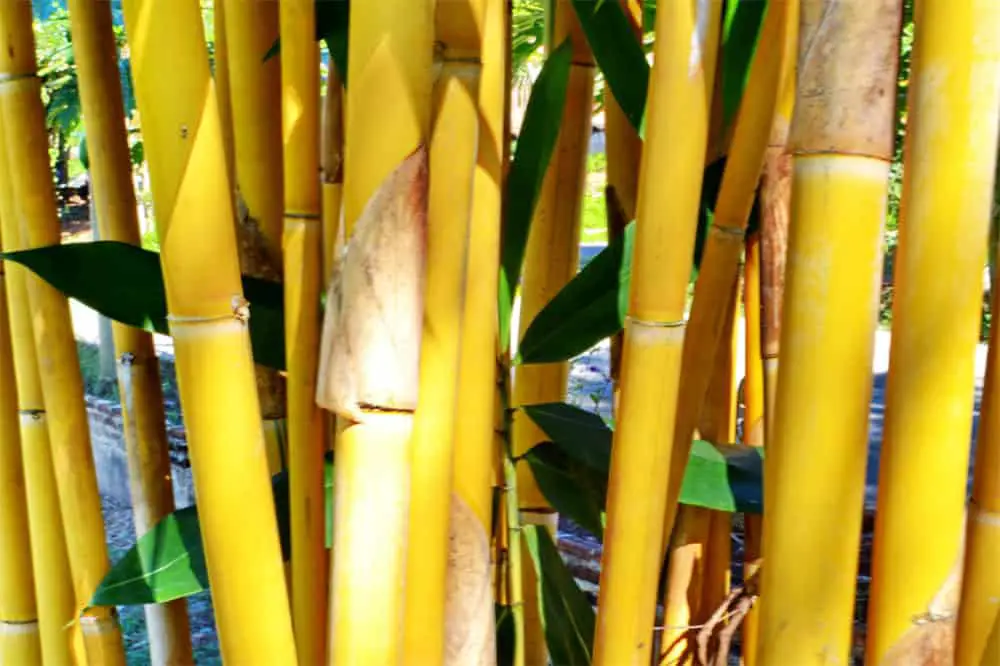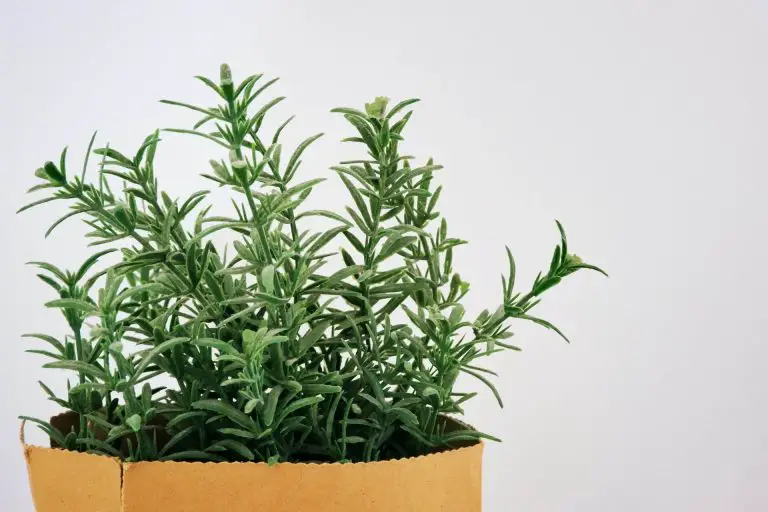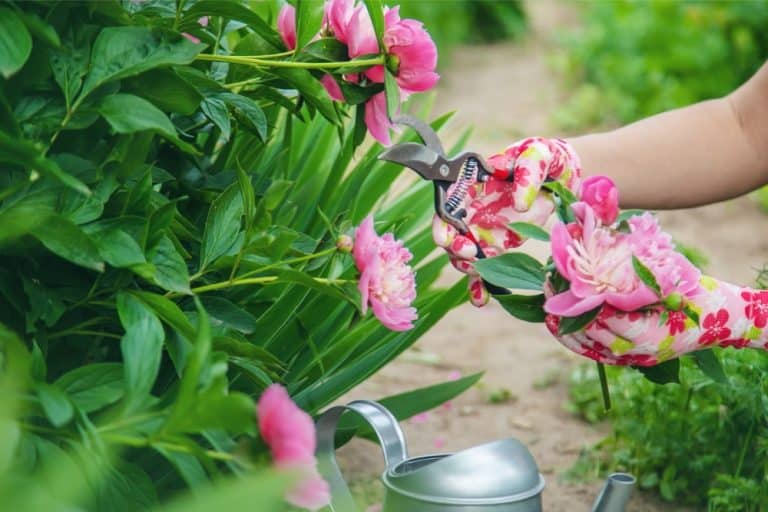Why Is My Bamboo Turning Yellow? [And How To Fix It!]
Are you wondering, Why Is My Bamboo Turning Yellow? Here is a quick and easy guide sharing all the reasons why and how to fix it!
Sometimes, a bamboo plant’s leaves can turn yellow. It’s okay, don’t panic! This isn’t always a bad thing, and often it’s normal! This can be either the bamboo leaves or the bamboo culms.
Whilst you shouldn’t panic, there’s never any harm in doing some research, as the yellowing might actually be the result of a nutrient deficiency.
Bamboo plants love to grow in wet and moist environments. Consider purchasing an automatic sprinkler system to ensure your plants are getting a constant water supply without the fuss of having to tend to them every day!

Related Articles:
- How Often To Water Bamboo [And Best Growing Tips!]
- How Big Should My Plants Be After 2 Weeks?
- How To Add Nitrogen To Soil
- What Do Plants Need To Grow And Survive? [2022 Guide!]
- How To Dry Willow Branches The RIGHT Way [2022 Guide]
DISCLAIMER
Some of the links on here are affiliate links and I may earn if you click on them, AT NO EXTRA cost to you. Hope you find the information here useful! Thanks.
When It’s Normal For Your Bamboo Leaf To Start Yellowing
To understand when it’s abnormal for your bamboo to start yellowing, we must first understand when it’s normal for it to yellow.
Many plants shed their leaves and regrow them, and bamboo plants are no different. In order to do this, the bamboo plant will stop the flow of nutrients to these leaves, meaning that they will turn yellow and drop off on their own.
Bamboo is evergreen, which means that it has leaves all year round. This is why the bamboo plant can sometimes have a mixture of green and yellow leaves. You will notice a greater proportion of yellow leaves around springtime than any other time of year. In these instances, yellow leaves are normal.
There are certain varieties of bamboo plants that can lose a lot of leaves at the same time, which can also be alarming.
This is why you should research your specific bamboo plant, as differences like this can cause needless worry. Even so – if your bamboo’s leaves suddenly turn yellow without any extra green leaves coming through afterward, there is a good chance that your bamboo plant is in need of some attention.
This is especially true if your bamboo plant’s leaves begin to turn yellow – this is a sign of a lack of water or nutrients. If you find that the tips of your bamboo leaves start to turn brown, your bamboo plant has probably been subjected to damage from the wind or needs more water.
Consider using a moisture meter to get accurate soil moisture reading, ensuring your bamboo plants are watered and happy!

Note– If you want to make your green fingers happier and your life easier, you can use this affordable 83 pieces ultimate gardening set to help you garden like a pro!
When It’s Normal For Your Bamboo Culm To Turn Yellow
This is often a normal occurrence, especially during or just before wintertime. If you notice that you have yellowing or even browning culms, you can trim them to make them look nicer, but there shouldn’t be anything bad happening.
Quite often, yellow culms are the result of owning a bamboo plant with naturally occurring yellow culms – as some varieties of bamboo mature, their culms may start to turn yellow.
Troubleshooting
If you’re certain that your bamboo plant isn’t a yellow variety of bamboo plant and that the yellowing is abnormal, it’s probably a sign that your bamboo plant is in need of something. We’ve put together a little troubleshooting guide to help you determine the problem!

What Color Are The Newest Leaves?
Bamboo plants will often have older leaves and newer leaves.
If the fresh leaves on your bamboo plant are turning yellow, there is a chance that your bamboo is lacking iron. Iron deficiency can often be the result of soil with a pH too high for your plant. This could be because your bamboo plant’s soil isn’t acidic enough.
If you believe that the problem might be with the pH of your soil, you can purchase a pH testing kit to make sure.
The pH balance of your soil can be rectified by adding something more acidic to the soil – this could be an ericaceous compost, an acidic plant food (such as a fertilizer with added iron), or sulfur.

All of these can be added to the soil in order to change the pH, however, please note that bamboo plants are particularly sensitive to over-fertilizing, so this should be done sparingly.
What Color Are The Oldest Leaves?
If you find that it’s the oldest leaves that are yellowing on your bamboo plant, this is probably the result of a nitrogen deficiency.
Sometimes, the older leaves on a bamboo plant can turn yellow before naturally dropping off, so you should make sure that this isn’t the case. If you find that they are unnaturally turning yellow, you may find that your bamboo needs nitrogen.
You can add nitrogen to your bamboo’s soil by using a fertilizer with a higher nitrogen content. Be careful when adding fertilizer, though – too much fertilizer can cause harm too.
Are The Leaves Turning Yellow?
Unlike some other plants, such as succulents, bamboo plants need quite a lot of water. If your bamboo plant has a lot of yellow or brown leaves, check the soil.
If you find that the soil is dry, this is an indication that your bamboo plant is dehydrated. This is an easy fix, as all you need to do is water your bamboo more often!
Are There Yellow Spots On The Bamboo Leaves?
If you find that there are pale, yellow spots on the leaves of your bamboo plant, you might have a pest problem.
Pale, yellow spots are often an indication of a mite infestation. There is a range of insecticides that you can use to get rid of mites, but you can also use home remedies, such as apple cider vinegar – however, home remedies may be less effective.
Is Your Soil Too Wet?
Whilst dehydration is bad for bamboo plants, if the soil surrounding your bamboo plant is too wet, you may notice yellowing leaves or culms. This is because bamboo needs soil that drains well, as this helps improve the flow of nutrients throughout the soil and therefore to the bamboo.
A mix of clay soil and organic compost is good for this, as the organic compost helps to break up the clay soil. Organic compost is also good for your bamboo, as organic compost adds extra nutrients to your soil!

Final Thoughts
If our troubleshooting guide doesn’t seem to help with your problem, there’s a good chance that it’s something in your environment contributing to the issue, whether that’s too much light, heat, wind – or the opposite.
A bamboo plant’s preferred conditions may differ based on the species of bamboo you have – some may prefer direct sunlight, whereas others may not. If in doubt, researching your specific bamboo plant and experimenting with these conditions in order to help them match your plant’s needs may help to reverse or prevent yellowing.
Hopefully, you’ve now got an understanding of why your bamboo plant may be yellowing and what you need to do to rectify it.
Well, there you have it. A quick and easy guide to your question: Why Is My Bamboo Turning Yellow?. if you need more info, we also shared a video below. Enjoy!


![How To Dig Steps Into A Hill [5 Easy Steps!]](https://aboveandbeyondgardening.com/wp-content/uploads/2021/10/How-To-Dig-Steps-Into-A-Hill-768x512.jpg)
![13 Companion Plants For Bok Choy-Best & Worst![2023]](https://aboveandbeyondgardening.com/wp-content/uploads/2022/10/Companion-Plant-For-Bok-Choy-8-768x511.jpg)

![How To Grow Tomatoes On A Fence: 6 Step Guide [2022]](https://aboveandbeyondgardening.com/wp-content/uploads/2022/08/how-to-grow-tomatoes-on-a-fence-6-768x512.jpg)

![How To Harvest Cilantro Without Killing The Plant?[The Best Way!]](https://aboveandbeyondgardening.com/wp-content/uploads/2022/10/how-to-harvest-cilantro-without-killing-the-plant-6-768x512.jpg)